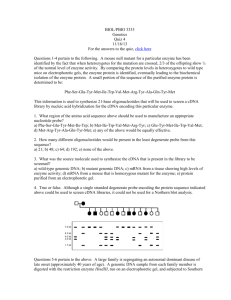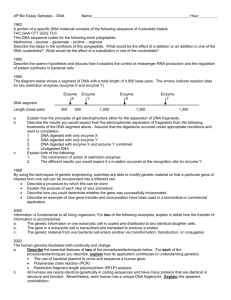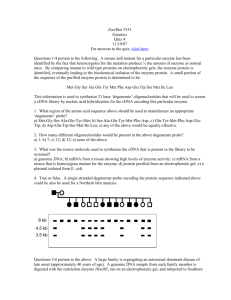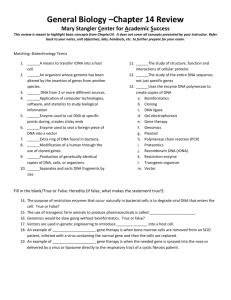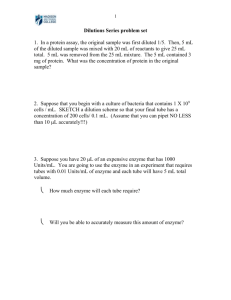BIOL/PBIO 3333 Genetics Quiz 4 11/14/14 For the answers to the
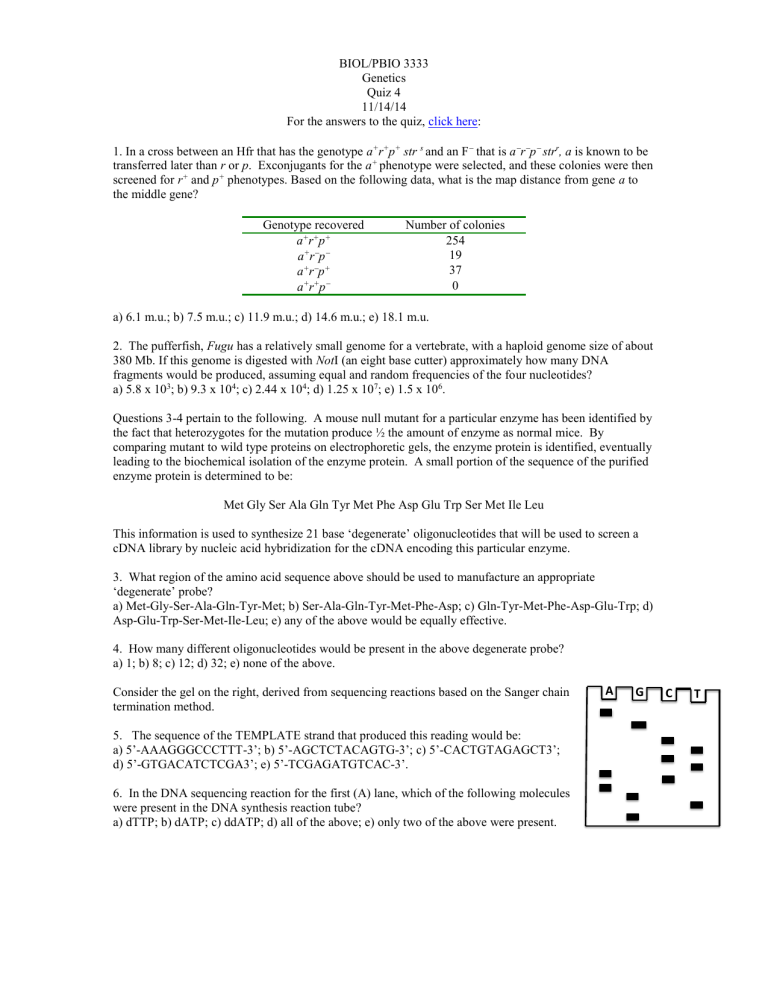
BIOL/PBIO 3333
Genetics
Quiz 4
11/14/14
For the answers to the quiz, click here :
1. In a cross between an Hfr that has the genotype a + r + p + str s and an F
that is a
r
p
str r , a is known to be transferred later than r or p . Exconjugants for the a + phenotype were selected, and these colonies were then screened for r + and p + phenotypes. Based on the following data, what is the map distance from gene a to the middle gene?
Genotype recovered a + r + p + a + r
p a a
+ r
p
+ r + p
+
Number of colonies
254
19
37
0 a) 6.1 m.u.; b) 7.5 m.u.; c) 11.9 m.u.; d) 14.6 m.u.; e) 18.1 m.u.
2. The pufferfish, Fugu has a relatively small genome for a vertebrate, with a haploid genome size of about
380 Mb. If this genome is digested with Not I (an eight base cutter) approximately how many DNA fragments would be produced, assuming equal and random frequencies of the four nucleotides? a) 5.8 x 10 3 ; b) 9.3 x 10 4 ; c) 2.44 x 10 4 ; d) 1.25 x 10 7 ; e) 1.5 x 10 6 .
Questions 3-4 pertain to the following. A mouse null mutant for a particular enzyme has been identified by the fact that heterozygotes for the mutation produce ½ the amount of enzyme as normal mice. By comparing mutant to wild type proteins on electrophoretic gels, the enzyme protein is identified, eventually leading to the biochemical isolation of the enzyme protein. A small portion of the sequence of the purified enzyme protein is determined to be:
Met Gly Ser Ala Gln Tyr Met Phe Asp Glu Trp Ser Met Ile Leu
This information is used to synthesize 21 base ‘degenerate’ oligonucleotides that will be used to screen a cDNA library by nucleic acid hybridization for the cDNA encoding this particular enzyme.
3. What region of the amino acid sequence above should be used to manufacture an appropriate
‘degenerate’ probe? a) Met-Gly-Ser-Ala-Gln-Tyr-Met; b) Ser-Ala-Gln-Tyr-Met-Phe-Asp; c) Gln-Tyr-Met-Phe-Asp-Glu-Trp; d)
Asp-Glu-Trp-Ser-Met-Ile-Leu; e) any of the above would be equally effective.
4. How many different oligonucleotides would be present in the above degenerate probe? a) 1; b) 8; c) 12; d) 32; e) none of the above.
A G C T Consider the gel on the right, derived from sequencing reactions based on the Sanger chain termination method.
5. The sequence of the TEMPLATE strand that produced this reading would be: a) 5’-AAAGGGCCCTTT-3’; b) 5’-AGCTCTACAGTG-3’; c) 5’-CACTGTAGAGCT3’; d) 5’-GTGACATCTCGA3’; e) 5’-TCGAGATGTCAC-3’.
6. In the DNA sequencing reaction for the first (A) lane, which of the following molecules were present in the DNA synthesis reaction tube? a) dTTP; b) dATP; c) ddATP; d) all of the above; e) only two of the above were present.
8.0
1 2 3 4 5 6 7 8 9 10
6.4
5.1
2.9
1.6
Questions 7-8 pertain to the above: A large family is segregating an autosomal dominant disease of late onset (approximately 40 years of age). A genomic DNA sample from each family member is digested with the restriction enzyme HindIII , run on an electrophoretic gel, and subjected to Southern blot analysis. The probe used in this instance hybridizes to a DNA fragment linked to the disease gene, which shows polymorphism for this restriction enzyme. The autoradiogram of this blot is shown above, aligned with the family pedigree.
7. In the above example, which of the following are physically linked to the disease gene allele in the affected parent? a) The 8 kb fragment; b) the 5.1 kb fragment; c) both the 5.1 and 2.9 kb fragments; d) the 6.4 kb fragment; e) none of the above.
8. Which of the following most accurately represents the map distance between the disease gene and the marker (probe DNA) locus? a) 0.02 map units; b) 1.8 map units; c) 10 map units; d) 12.5 map units; e) 22 map units.
Questions 9 and 10 pertain to the following. Six independently derived mutants are recovered in Neurospora that are all able to grow on compound Z. The mutants are then grown on minimal media supplemented with one of 6 chemicals all known to be precursors to compound Z. A summary of the ability of the mutants to grow on media containing these chemicals is indicated below, where a “+” sign indicates growth and a “-” sign indicates no growth.
Mutant number
1
2
3
4
5
6
A
+
+
+
B
+
+
+
+
+
Chemical Compounds
C
+
+
+
+
D
+
E
F
+
+
9. The immediate precursor to compound Z (i.e. next to last compound in pathway) is: a) E; b) C; c) F; d) A; e) none of the above.
10. A mutation in gene 2 should lead to an accumulation in which metabolite in the pathway? a) E; b) C; c) D; d) A; e) none of the above.
Z
+
+
+
+
+
+
